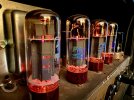NoAccording to the very basic manual with the THD (more a sheet than a manual) -
Q. “Can I still use the Hot Plate if it has a different impedance than my amp?
A. ONLY if the impedance of the Hot Plate is EQUAL TO OR GREATER THAN that of the amp. However, this will lessen the effectiveness of the Hot Plate’s tone controls.
Q. “If I am using just one speaker cabinet, can I still use the Hot Plate if it has a different impedance than my speaker cabinet?”
A. ONLY if the impedance of the speakers is equal to or greater than the amplifier, AND the impedance of the Hot Plate is equal to or greater than the amp. Again, this will lessen the effectiveness of the Hot Plate’s tone controls.
I’ll keep searching but my main lack of understanding is the can setup. Again I have two 16 Ohm speakers (as per photo) and I do not know whether these are in series or in parallel (sorry, never rebuilt a cab before).
My current understand on impedance is that 2 16 Ohm in parallel is 16/2 = 8 ohm. If that’s correct then I get it…..so I either buy a 4x12, 8 ohm attenuator or change the speakers to be in series?
You are fine. Your amp matches your attenuator. Period.
You can use your cab (it will be 8ohms - pair of 16s in parallel. No one has 32 ohm guitar cabs!) out of your current Hotplate without issue.

